TecFocus has partnered with numerous small businesses on SBIR and other DoD contracts. These companies include Digital Systems Resources (now part of general Dynamics-AIS), ORINCON (now part of Lockheed-Martin), SARA Inc, LassonTechnologies, Inc., and CornerTurn LLC. These efforts have resulted in significant proprietary technical innovations, some of which are summarized below.
Environmentally Insensitive Decluttering
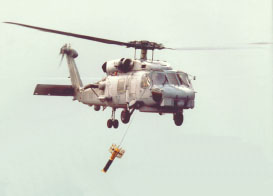 This work was perfromed on Navy SBIR N00-008 for NAVAIR. It developed techniques to provide environmentally robust decluttering and classification of active sonar returns specifically tailored for the dipping sonar of the MH-60R. The approach is to extend non-parametric detection concepts to the estimation problem of decluttering and classification. TecFocus identified and developed an innovative, non-parametric technique for combining existing classification clues that is the basis for this effort. The technique was tested on data from the Navy's Echo Tracker Classifier program and on dippping sonar data collected at AUTEC. This SBIR was successfully transitioned to Phase III at General Dynamics-AIS.
Under a 2015 SBIR from the Missile Defense Agency, the algorithm was adapted to radar use. This work was perfromed on Navy SBIR N00-008 for NAVAIR. It developed techniques to provide environmentally robust decluttering and classification of active sonar returns specifically tailored for the dipping sonar of the MH-60R. The approach is to extend non-parametric detection concepts to the estimation problem of decluttering and classification. TecFocus identified and developed an innovative, non-parametric technique for combining existing classification clues that is the basis for this effort. The technique was tested on data from the Navy's Echo Tracker Classifier program and on dippping sonar data collected at AUTEC. This SBIR was successfully transitioned to Phase III at General Dynamics-AIS.
Under a 2015 SBIR from the Missile Defense Agency, the algorithm was adapted to radar use.
GPS Enhancement through Broadband Noise Reduction
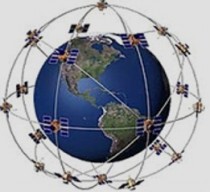 Working with CornerTurn LLC, TecFocus developed a processing technique that is compatible with existing GPS receiver architectures which provides improved cold and warm start performance, with reliable assisted acquisition at input signal levels below -161 dBm. TecFocus and CornerTurn have a patent pending on this technique, known as Broadband Noise Reduction (BBNR). BBNR also shows potential for NAVbit decoding at lower signal-to-noise ratios. The performance improvement of the BBNR applied to GPS assisted acquisition has been estimated through processing of simulated GPS signals in a MATLAB implementation of the BBNR technique. This simulation was used to determine the signal-to-noise ratio at the FFT output, which provides a measure of the acquisition performance of the receiver. Working with CornerTurn LLC, TecFocus developed a processing technique that is compatible with existing GPS receiver architectures which provides improved cold and warm start performance, with reliable assisted acquisition at input signal levels below -161 dBm. TecFocus and CornerTurn have a patent pending on this technique, known as Broadband Noise Reduction (BBNR). BBNR also shows potential for NAVbit decoding at lower signal-to-noise ratios. The performance improvement of the BBNR applied to GPS assisted acquisition has been estimated through processing of simulated GPS signals in a MATLAB implementation of the BBNR technique. This simulation was used to determine the signal-to-noise ratio at the FFT output, which provides a measure of the acquisition performance of the receiver.
Auditory Devices for Remote Detection
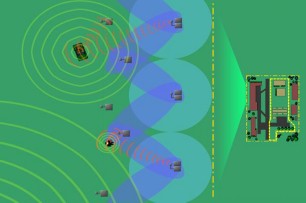 TecFocus teamed with Digital Systems Resources, Inc on this Air Force SBIR project AF0-086, which developed an in-air, active acoustic system to provide detection, localization and classification of stealthy intruders trying to compromise a perimeter. TecFocus responsibility on this effort included performance analysis, definition and prototyping of signal processing, participation in field testing, and data analysis. The prototype developed successfully combined an existing short-range sensor technology with historical sonar signal processing concepts to develop a perimeter sensor with tactically significant detection range. This sensor is intended to be part of an overall system designed to detect all on-foot and mechanical “intruders” approaching a perimeter. The eventual multi-sensor system is envisioned to include acoustics (active and passive), infrared, video and radar. The Phase II effort delivered a fully functional prototype system that was successfully tested for intruder detection at Wright Patterson Air Force Base. A US Patent jointly owned by TecFocus and DSR (now GD-AIS) has been issued for this technique TecFocus teamed with Digital Systems Resources, Inc on this Air Force SBIR project AF0-086, which developed an in-air, active acoustic system to provide detection, localization and classification of stealthy intruders trying to compromise a perimeter. TecFocus responsibility on this effort included performance analysis, definition and prototyping of signal processing, participation in field testing, and data analysis. The prototype developed successfully combined an existing short-range sensor technology with historical sonar signal processing concepts to develop a perimeter sensor with tactically significant detection range. This sensor is intended to be part of an overall system designed to detect all on-foot and mechanical “intruders” approaching a perimeter. The eventual multi-sensor system is envisioned to include acoustics (active and passive), infrared, video and radar. The Phase II effort delivered a fully functional prototype system that was successfully tested for intruder detection at Wright Patterson Air Force Base. A US Patent jointly owned by TecFocus and DSR (now GD-AIS) has been issued for this technique
MCM Technologies for Detection, Classification and Localization of Sea Mines
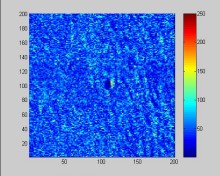 On Navy SBIR N00-112, TecFocus and DSR (with TecFocus as prime contractor) investigated innovative techniques to use combined bistatic and monostatic processing to detect and classify underwater mines automatically on unmanned autonomous underwater vehicles. The Phase I effort validated that the basic approach provides the 2-dimensional resolution required to discriminate underwater mines at significantly increased ranges compared to typical high frequency imaging sonars. In Phase II, a prototype system was implemented and tested on (1) simulated data developed from mine images and (2) actual sonar data. On Navy SBIR N00-112, TecFocus and DSR (with TecFocus as prime contractor) investigated innovative techniques to use combined bistatic and monostatic processing to detect and classify underwater mines automatically on unmanned autonomous underwater vehicles. The Phase I effort validated that the basic approach provides the 2-dimensional resolution required to discriminate underwater mines at significantly increased ranges compared to typical high frequency imaging sonars. In Phase II, a prototype system was implemented and tested on (1) simulated data developed from mine images and (2) actual sonar data.
Platform Noise Reduction
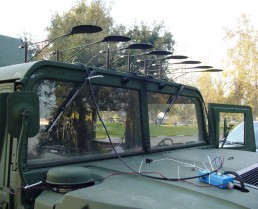 This work was performed with Digital Systems Resources on the Army SBIR A00-106, which investigated the innovative combination of noise canceling, broadband noise reduction and adaptive beamforming to reduce near field noise on Army vehicles in order to allow passive acoustic detection of targets in the far field. TecFocus provided its world-class expertise in adaptive noise cancellation to this effort. The effort also developed Broadband Noise Reduction techniques to deal with wind and road noise. These techniques have been subsequently further refined and test on data from several other in-air acoustic systems for Textron, Inc.and SARA, Inc. The figure shows the microphone installation on an Army HMMWV vehicle that was used during thefield testing phase of the SBIR. At the midpoint of the Phase II The figure shows the reduction of broadband background, allowing detection of tones of interest. At the midpoint of the Phase II effort, a successful field demonstration was conducted that validated effective own-platform noise cancellation, spatial beamforming using an array with an extremely small aperture, and adaptive processing that lowered broadband background noise 20-35 dB. A fully functional prototype was developed and installed on an Army vehicle, then successfully demonstrated at Aberdeen Proving Grounds in December of 2003. This work was performed with Digital Systems Resources on the Army SBIR A00-106, which investigated the innovative combination of noise canceling, broadband noise reduction and adaptive beamforming to reduce near field noise on Army vehicles in order to allow passive acoustic detection of targets in the far field. TecFocus provided its world-class expertise in adaptive noise cancellation to this effort. The effort also developed Broadband Noise Reduction techniques to deal with wind and road noise. These techniques have been subsequently further refined and test on data from several other in-air acoustic systems for Textron, Inc.and SARA, Inc. The figure shows the microphone installation on an Army HMMWV vehicle that was used during thefield testing phase of the SBIR. At the midpoint of the Phase II The figure shows the reduction of broadband background, allowing detection of tones of interest. At the midpoint of the Phase II effort, a successful field demonstration was conducted that validated effective own-platform noise cancellation, spatial beamforming using an array with an extremely small aperture, and adaptive processing that lowered broadband background noise 20-35 dB. A fully functional prototype was developed and installed on an Army vehicle, then successfully demonstrated at Aberdeen Proving Grounds in December of 2003.
Multistatic Operations
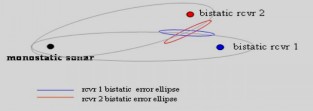 This work was performed on Navy SBIR N00-009 for NAVAIR. It developed techniques to reduce the prosecution time in pursuit of submarines, by improving sonar localization accuracy based on bistatic processing techniques. TecFocus was responsible for the development of algorithms that use known target characteristics and potential target evasive maneuvers to determine an effective sensor deployment strategy during localization and prosecution. The advantages of using a sonobuoy multistatically with ALFS were also determined. This SBIR was successfully transitioned to Phase III at General Dynamics-AIS. This work was performed on Navy SBIR N00-009 for NAVAIR. It developed techniques to reduce the prosecution time in pursuit of submarines, by improving sonar localization accuracy based on bistatic processing techniques. TecFocus was responsible for the development of algorithms that use known target characteristics and potential target evasive maneuvers to determine an effective sensor deployment strategy during localization and prosecution. The advantages of using a sonobuoy multistatically with ALFS were also determined. This SBIR was successfully transitioned to Phase III at General Dynamics-AIS.
Surveillance of Ship Security Perimeters While in Port
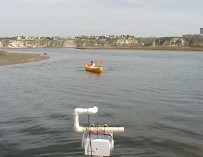 This work was performed on Navy SBIR N01-118, which developed a unique sensor for use in protecting Navy ships in port. This sensor was designed to detect stealthy intruders approaching over land or water. A complete demonstration system, including sensors, signal processing and automatic detection was demonstrated in Phase I. The figure shows a prototype sensor being tested against a small surface craft.. A concept for integrating the sensor with others in a layered defense system using data fusion was also developed. This work was performed on Navy SBIR N01-118, which developed a unique sensor for use in protecting Navy ships in port. This sensor was designed to detect stealthy intruders approaching over land or water. A complete demonstration system, including sensors, signal processing and automatic detection was demonstrated in Phase I. The figure shows a prototype sensor being tested against a small surface craft.. A concept for integrating the sensor with others in a layered defense system using data fusion was also developed.
| 

 Working with CornerTurn LLC, TecFocus developed a processing technique that is compatible with existing GPS receiver architectures which provides improved cold and warm start performance, with reliable assisted acquisition at input signal levels below -161 dBm. TecFocus and CornerTurn have a patent pending on this technique, known as Broadband Noise Reduction (BBNR). BBNR also shows potential for NAVbit decoding at lower signal-to-noise ratios. The performance improvement of the BBNR applied to GPS assisted acquisition has been estimated through processing of simulated GPS signals in a MATLAB implementation of the BBNR technique. This simulation was used to determine the signal-to-noise ratio at the FFT output, which provides a measure of the acquisition performance of the receiver.
Working with CornerTurn LLC, TecFocus developed a processing technique that is compatible with existing GPS receiver architectures which provides improved cold and warm start performance, with reliable assisted acquisition at input signal levels below -161 dBm. TecFocus and CornerTurn have a patent pending on this technique, known as Broadband Noise Reduction (BBNR). BBNR also shows potential for NAVbit decoding at lower signal-to-noise ratios. The performance improvement of the BBNR applied to GPS assisted acquisition has been estimated through processing of simulated GPS signals in a MATLAB implementation of the BBNR technique. This simulation was used to determine the signal-to-noise ratio at the FFT output, which provides a measure of the acquisition performance of the receiver.  TecFocus teamed with Digital Systems Resources, Inc on this Air Force SBIR project AF0-086, which developed an in-air, active acoustic system to provide detection, localization and classification of stealthy intruders trying to compromise a perimeter. TecFocus responsibility on this effort included performance analysis, definition and prototyping of signal processing, participation in field testing, and data analysis. The prototype developed successfully combined an existing short-range sensor technology with historical sonar signal processing concepts to develop a perimeter sensor with tactically significant detection range. This sensor is intended to be part of an overall system designed to detect all on-foot and mechanical “intruders” approaching a perimeter. The eventual multi-sensor system is envisioned to include acoustics (active and passive), infrared, video and radar. The Phase II effort delivered a fully functional prototype system that was successfully tested for intruder detection at Wright Patterson Air Force Base. A US Patent jointly owned by TecFocus and DSR (now GD-AIS) has been issued for this technique
TecFocus teamed with Digital Systems Resources, Inc on this Air Force SBIR project AF0-086, which developed an in-air, active acoustic system to provide detection, localization and classification of stealthy intruders trying to compromise a perimeter. TecFocus responsibility on this effort included performance analysis, definition and prototyping of signal processing, participation in field testing, and data analysis. The prototype developed successfully combined an existing short-range sensor technology with historical sonar signal processing concepts to develop a perimeter sensor with tactically significant detection range. This sensor is intended to be part of an overall system designed to detect all on-foot and mechanical “intruders” approaching a perimeter. The eventual multi-sensor system is envisioned to include acoustics (active and passive), infrared, video and radar. The Phase II effort delivered a fully functional prototype system that was successfully tested for intruder detection at Wright Patterson Air Force Base. A US Patent jointly owned by TecFocus and DSR (now GD-AIS) has been issued for this technique On Navy SBIR N00-112, TecFocus and DSR (with TecFocus as prime contractor) investigated innovative techniques to use combined bistatic and monostatic processing to detect and classify underwater mines automatically on unmanned autonomous underwater vehicles. The Phase I effort validated that the basic approach provides the 2-dimensional resolution required to discriminate underwater mines at significantly increased ranges compared to typical high frequency imaging sonars. In Phase II, a prototype system was implemented and tested on (1) simulated data developed from mine images and (2) actual sonar data.
On Navy SBIR N00-112, TecFocus and DSR (with TecFocus as prime contractor) investigated innovative techniques to use combined bistatic and monostatic processing to detect and classify underwater mines automatically on unmanned autonomous underwater vehicles. The Phase I effort validated that the basic approach provides the 2-dimensional resolution required to discriminate underwater mines at significantly increased ranges compared to typical high frequency imaging sonars. In Phase II, a prototype system was implemented and tested on (1) simulated data developed from mine images and (2) actual sonar data.  This work was performed on Navy SBIR N00-009 for NAVAIR. It developed techniques to reduce the prosecution time in pursuit of submarines, by improving sonar localization accuracy based on bistatic processing techniques. TecFocus was responsible for the development of algorithms that use known target characteristics and potential target evasive maneuvers to determine an effective sensor deployment strategy during localization and prosecution. The advantages of using a sonobuoy multistatically with ALFS were also determined. This SBIR was successfully transitioned to Phase III at General Dynamics-AIS.
This work was performed on Navy SBIR N00-009 for NAVAIR. It developed techniques to reduce the prosecution time in pursuit of submarines, by improving sonar localization accuracy based on bistatic processing techniques. TecFocus was responsible for the development of algorithms that use known target characteristics and potential target evasive maneuvers to determine an effective sensor deployment strategy during localization and prosecution. The advantages of using a sonobuoy multistatically with ALFS were also determined. This SBIR was successfully transitioned to Phase III at General Dynamics-AIS.